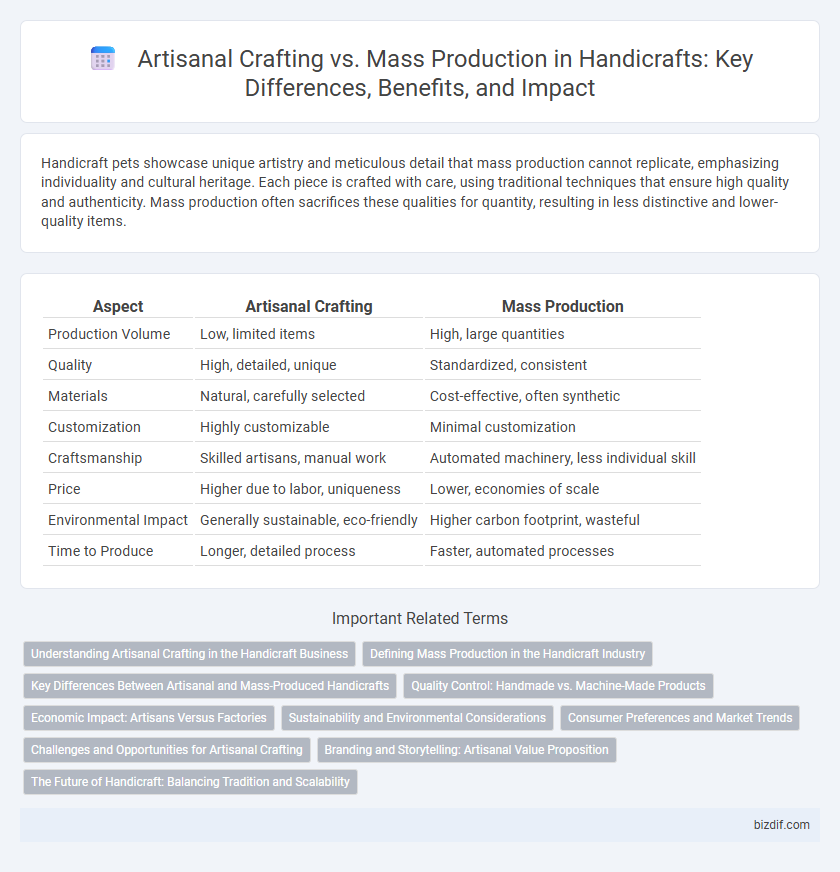Handicraft pets showcase unique artistry and meticulous detail that mass production cannot replicate, emphasizing individuality and cultural heritage. Each piece is crafted with care, using traditional techniques that ensure high quality and authenticity. Mass production often sacrifices these qualities for quantity, resulting in less distinctive and lower-quality items.
Table of Comparison
| Aspect | Artisanal Crafting | Mass Production |
|---|---|---|
| Production Volume | Low, limited items | High, large quantities |
| Quality | High, detailed, unique | Standardized, consistent |
| Materials | Natural, carefully selected | Cost-effective, often synthetic |
| Customization | Highly customizable | Minimal customization |
| Craftsmanship | Skilled artisans, manual work | Automated machinery, less individual skill |
| Price | Higher due to labor, uniqueness | Lower, economies of scale |
| Environmental Impact | Generally sustainable, eco-friendly | Higher carbon footprint, wasteful |
| Time to Produce | Longer, detailed process | Faster, automated processes |
Understanding Artisanal Crafting in the Handicraft Business
Artisanal crafting in the handicraft business emphasizes meticulous handwork, unique designs, and cultural authenticity, contrasting sharply with the uniformity and scale of mass production. Each artisanal product reflects skill, tradition, and individual creativity, creating higher value and emotional connection for consumers. Understanding the detailed techniques and heritage behind artisanal crafts enables businesses to differentiate their offerings and cater to niche markets seeking genuine, handcrafted goods.
Defining Mass Production in the Handicraft Industry
Mass production in the handicraft industry refers to the large-scale manufacturing of products using standardized processes and machinery, often prioritizing quantity over uniqueness. This method contrasts sharply with artisanal crafting, as it emphasizes uniformity and efficiency, enabling faster output but typically sacrificing the individuality and intricate details found in handmade items. Factories producing mass-crafted goods utilize assembly lines and automation to replicate designs, reducing the time and cost per unit while limiting the personal touch inherent in traditional handicrafts.
Key Differences Between Artisanal and Mass-Produced Handicrafts
Artisanal crafting emphasizes unique, handmade products created with traditional techniques and personalized attention to detail, resulting in high-quality, one-of-a-kind items. In contrast, mass production relies on automated processes and standardized designs to produce large quantities of identical handicrafts, often sacrificing individual craftsmanship for efficiency. The key differences lie in the value of originality, craftsmanship, and the cultural significance attributed to artisanal products compared to the uniformity and scalability of mass-produced goods.
Quality Control: Handmade vs. Machine-Made Products
Artisanal crafting emphasizes meticulous quality control through hands-on inspection and customization, ensuring unique, durable, and high-quality handmade products. In contrast, mass production relies on standardized machine processes and automated inspections, often prioritizing quantity over individual product refinement. Handmade items typically exhibit superior attention to detail and craftsmanship that machine-made goods cannot replicate.
Economic Impact: Artisans Versus Factories
Artisanal crafting supports local economies by generating sustainable employment and preserving cultural heritage, often resulting in unique, high-value products with higher profit margins per unit. Mass production, driven by factories, yields large quantities at lower costs, boosting industrial GDP but frequently leading to job displacement due to automation and reduced skill requirements. The economic impact of artisanal versus factory production hinges on balancing community empowerment with scalability and market accessibility.
Sustainability and Environmental Considerations
Artisanal crafting prioritizes sustainability by utilizing locally sourced, natural materials and minimizing waste through handcrafted techniques, contrasting sharply with mass production's reliance on synthetic materials and high energy consumption. Handicrafts often incorporate eco-friendly practices like recycling and traditional dyeing methods that reduce environmental impact. This emphasis on sustainable methods supports biodiversity and fosters community resilience, making artisanal products more environmentally responsible than mass-produced alternatives.
Consumer Preferences and Market Trends
Artisanal crafting appeals to consumers seeking unique, high-quality, and sustainably made products, driving demand in niche markets that value authenticity and craftsmanship. Mass production dominates mainstream markets due to its ability to offer lower prices and consistent availability, attracting price-sensitive consumers. Current market trends reveal a growing preference for handcrafted goods as buyers increasingly prioritize ethical sourcing and personalized products over mass-produced alternatives.
Challenges and Opportunities for Artisanal Crafting
Artisanal crafting faces challenges such as limited scalability, higher production costs, and difficulties in accessing global markets compared to mass production. Opportunities arise from growing consumer demand for unique, high-quality, and ethically-made products, allowing artisans to leverage storytelling and cultural authenticity. Digital platforms and niche marketing enable artisans to reach targeted consumers, overcoming traditional distribution barriers.
Branding and Storytelling: Artisanal Value Proposition
Artisanal crafting emphasizes unique, handcrafted qualities that enhance brand authenticity and consumer trust, differentiating products through compelling storytelling rooted in tradition and craftsmanship. This personalized narrative fosters emotional connections, elevating brand identity beyond mass-produced goods lacking individual character. Highlighting artisans' skills and cultural heritage strengthens the value proposition, attracting conscious consumers seeking meaningful and exclusive purchases.
The Future of Handicraft: Balancing Tradition and Scalability
Artisanal crafting preserves cultural heritage through unique, handmade products that emphasize quality and individuality, while mass production offers scalability and cost efficiency needed for global markets. Integrating advanced technology with traditional techniques creates a future where handicraft can meet increasing demand without losing authenticity. Sustainable practices and digital platforms help artisans expand their reach, balancing heritage preservation with commercial growth.
Artisanal Crafting vs Mass Production Infographic

 bizdif.com
bizdif.com